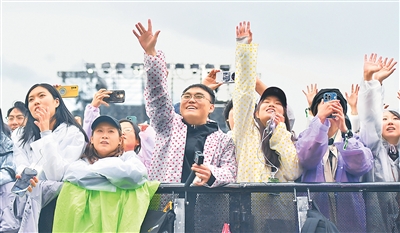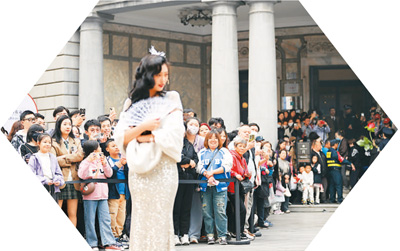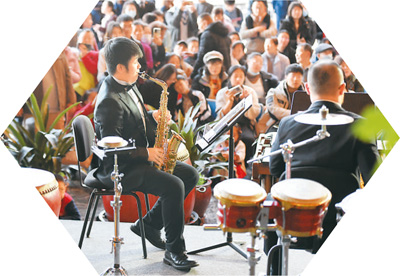




- BRNN
- BRI News
- BRNN News
- Database
Official Documents Polices and Regulations
Inter-government Documents International Cooperation BRI Countries
Business Guide Economic Data BRI Data
Trade
Investment Projects Latest projects
Cases - Content Pool
A growing number of young people in China are fueling demand for live entertainment, reshaping the country's offline performance market.
Total revenue in China's performance sector reached 79.63 billion yuan ($11.05 billion) in 2024, up 7.6 percent from a year earlier, according to the China Association of Performing Arts. Box office revenue alone rose 15.4 percent to 57.95 billion yuan.
The growth of the performance market has significantly boosted cultural and tourism spending.

Photo shows audience members at the Strawberry Music Festival in Beijing, May 2, 2025. (Xinhua/Xiao Xiao)
Content in the performance market is also becoming more diverse. In addition to popular concerts and music festivals, new forms of live entertainment are emerging as sources of inspiration for young audiences.
Huang Zitian, a 21-year-old musical theater enthusiast, visits theaters at least once or twice a month. She recalled her experience watching a musical on New Year's Eve.
"During the performance, I felt as if I was running through maze-like scenes alongside the actors. That immersive experience is something I simply can't get from watching videos online. When everyone shouted 'Happy New Year' together at midnight, the sense of ritual was truly unforgettable," she said.
Stand-up comedy has become a new favorite among young audiences seeking stress relief. Data from the China Association of Performing Arts shows that in 2024, stand-up comedy recorded the largest increases in both the number of performances and box office revenue at small theaters and new venues, rising by 53 percent and 48 percent, respectively.
Performance venues are expanding beyond first-tier cities, with second- and third-tier cities emerging as new hotspots. According to data from Beacon Pro, second-tier cities accounted for more than 60 percent of both box office revenue and performance numbers for large-scale concerts in 2024.
Third- and fourth-tier cities represented 29.1 percent of music festival box office revenue, up 3.8 percentage points year on year, and their share of performance numbers reached 34.9 percent, an increase of 2.7 percentage points from the previous year.

Audience members watch a drama on a street in north China's Tianjin Municipality. (Xinhua/Li Ran)
Young consumers are increasingly willing to travel across cities to attend performances, driven by a mix of personalization, emotional value and a desire for social connection.
Media surveys show that relaxation and entertainment, the participation of favorite idols or artists, interest in performance content and immersive experiences are among the top factors young people consider when choosing live events. Additionally, 79.4 percent of respondents believe that performances provide emotional value and help calm the mind.
Tan Xiaoya, a student at Huazhong University of Science and Technology in Hubei Province, has made it a habit to go to the theater after each exam period.
"In the theater, I can momentarily empty my mind and immerse myself in another world. Watching performances is my way of relieving stress," she said.
Paying for emotional value has become a consumption trend among young people, according to Wu Liyun, a professor at the China Academy of Culture and Tourism at Beijing International Studies University.
"Whether traveling to attend performances or purchasing related merchandise and cultural products during trips, these behaviors reflect young consumers' growing emphasis on the emotional satisfaction that consumption brings. They are increasingly willing to pay for products and services that provide emotional value," Wu said.
Offline performances are also becoming a social connector for young people.
During the May Day holiday this year, the Cactus Music Festival in Wuhan, Hubei Province, attracted nearly 60,000 music fans from across the country. Among them were Shan Wenjie from Guangdong Province in the south and Wu Nan from the Inner Mongolia Autonomous Region in the north — graduate school classmates who had not seen each other for two years since graduation. They used the music festival as an opportunity to reunite, enjoy the festival atmosphere and explore Wuhan together.

Performers play music in front of a cafe at the National Centre for the Performing Arts. (Xinhua/Luo Xiaoguang)
On social media, sharing ticket stubs for performances has become a form of "social currency" among young people. After attending events, many write ticket-buying guides, share their experiences and post photos of ticket stubs and related merchandise as part of their personal "rituals" for watching performances.
Short video clips and widespread discussions on social media have attracted more young people to live events, further boosting offline performance consumption.
He Zhiwu, a professor at the School of Journalism and Information Communication at Huazhong University of Science and Technology, said that online performance clips and social media spark curiosity among young audiences.
New consumption trends among young people are influencing and reshaping the offline performance market. Continuous innovation in performance content and new formats are offering consumers a richer cultural experience.
According to He, as young people become the main driving force in the offline performance market, their preferences and ideas are set to spur further changes in the industry.
More shows now reflect the interests of today's youth, blending traditional classics with modern styles and creativity. Immersive experiences and audience participation have also become common features of live performances.
"Performance venues will become more diverse, with events integrating esports, dining and other business formats. Cross-sector and cross-venue performances will become increasingly common," He said.
He added that new technology and immersive stage effects will make performances more engaging, allowing young people to find emotional connection and personal satisfaction in their experiences.

Tel:86-10-65363107, 86-10-65368220, 86-10-65363106